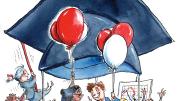Many of the most pressing issues of our time—climate change, economic inequality, human rights—require interdisciplinary solutions. Yet facilitating collaboration among individuals from disparate fields can often be challenging. A recent study on what contributes to successful interdisciplinary work has found that the “emotional aspect” of such collaborations is at least as important as their intellectual aspect.
The study, by professor of sociology Michele Lamont, lecturer on education Veronica Boix Mansilla, and Kyoko Sato, now a lecturer at Stanford, closely examined nine interdisciplinary networks funded by the Canadian Institute for Advanced Research, the MacArthur Foundation, and the Santa Fe Institute. These networks all brought together scholars from at least three disciplines; their research topics ranged from brain development to urbanization. Drawing on documents, observation, surveys, and interviews, the authors concluded that the markers of successful interdisciplinary collaborations include not just an intellectual, but also emotional and interactional elements, and they proposed a “shared cognitive-emotional-interactional platform” for evaluating such projects.
Lamont said the findings may appear counterintuitive. “Instead of thinking that the emotional and the interactional corrupt the cognitive,” as the issue has often been framed in the literature, she explained, the authors view the first two dimensions “as interacting with knowledge production and as empowering.” Successful interdisciplinary networks, she continued, are characterized by a “collective effervescence” that involves mutual respect and learning among team members.
When accomplished experts of different disciplines sit around one table, added Boix Mansilla, the resulting interaction is comparable to an intercultural dialogue, with all the ancillary stereotypes and assumptions about “the other.” The participants often underplay the need to construct an emotional cohesiveness—which the study found to be integral. “What our study suggests is that we need to pay special attention to something that we sometimes take for granted or forget,” she said. Successful collaboration requires the construction of a group identity, which Boix Mansilla encapsulates as “a sense of ‘us’; the degree to which a team can get excited about the idea and the leaders can keep this intellectual excitement alive.”
One group illustrating successful collaboration, Lamont said, was the MacArthur Foundation’s Research Network on Adolescent Development and Juvenile Justice, which probed the origins, development, and prevention of juvenile crimes. The team’s work, she explained, has helped lead to changes in the courtroom. The collaboration produced an influential article quoted in the landmark 2005 Supreme Court decision that outlawed the death penalty for juvenile offenders. Kyoko Sato said that what distinguished this group were the positive interactional and emotional features that facilitated dialogues among participants ranging from legal officials to experts in psychology, public health, and education. “They really liked each other,” she said, “and they were also all bonded in a collective mission to make a difference in the juvenile-justice system.”
Howard Gardner, Hobbs professor of cognition and education at the Graduate School of Education, who has led a study on interdisciplinary collaboration in the past, called the paper an “ambitious” and “creative synthesis” of various kinds of data. “I don’t know of any study that looked at longstanding networks over a significant period of time,” he said. “This is not the type of question that you can answer simply by doing a lengthy online survey; it doesn’t lend itself to large-scale ‘big-data’ methods.” His own research on successful collaborations yielded similar people-centered findings that emphasized factors such as the rigorous selection of team members and good leadership. “People need to like each other,” he said. “Nobody wants to work for years on something if he or she doesn’t like the other people.”
The major takeaway from the study, Lamont said, is that researchers should choose their collaborators carefully, assessing not just intellectual contribution, but also emotional intelligence and personality. “The days of the titans who dominated their disciplines at Harvard and elsewhere may be obsolete one day,” Lamont said, “because the key to innovation is now often collaboration.”









